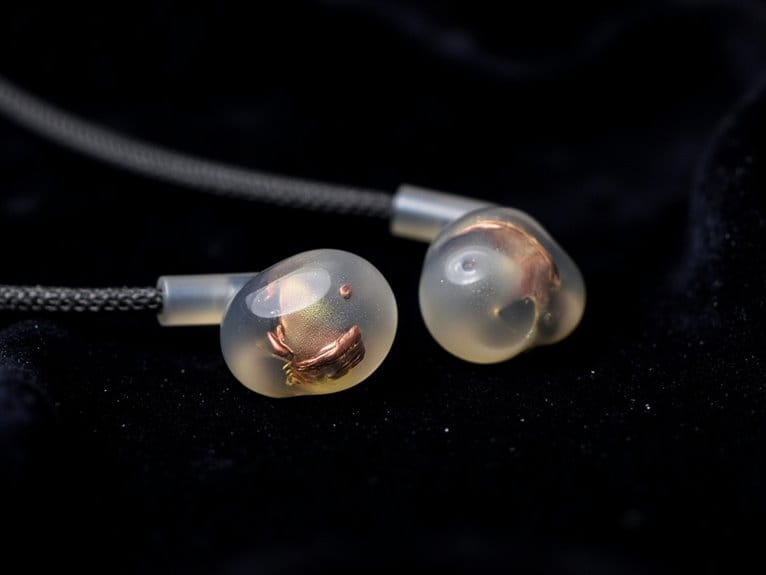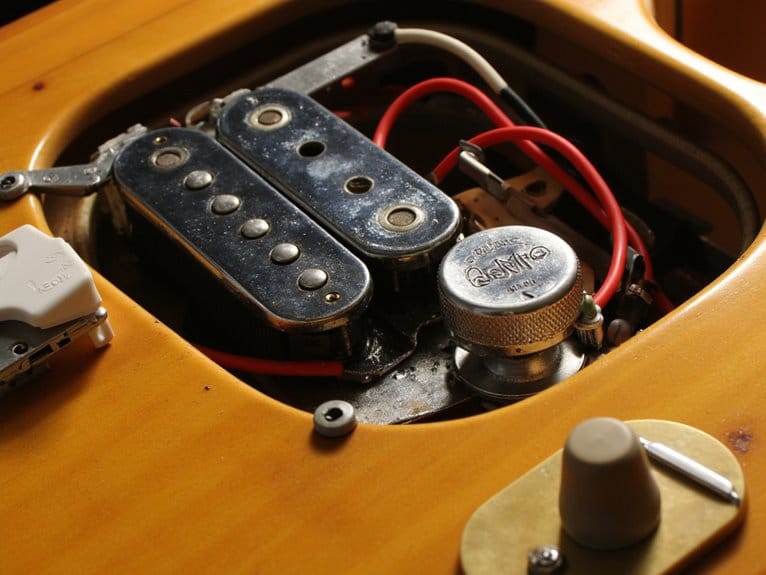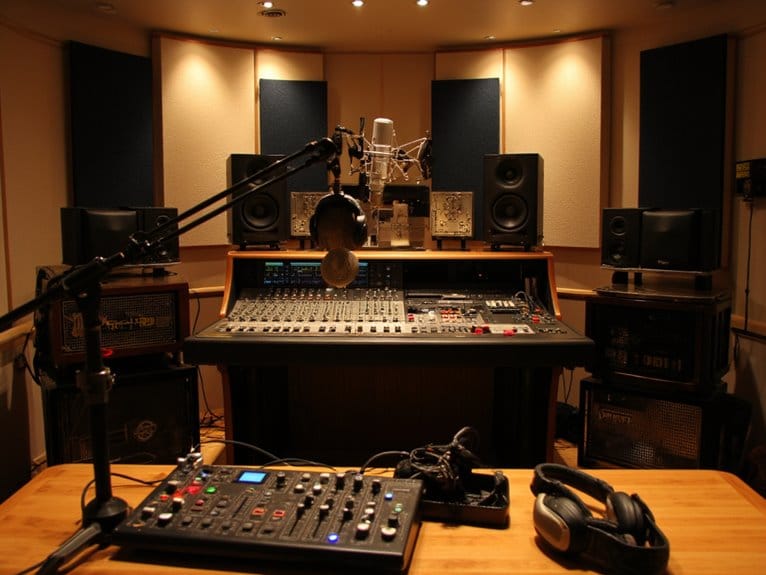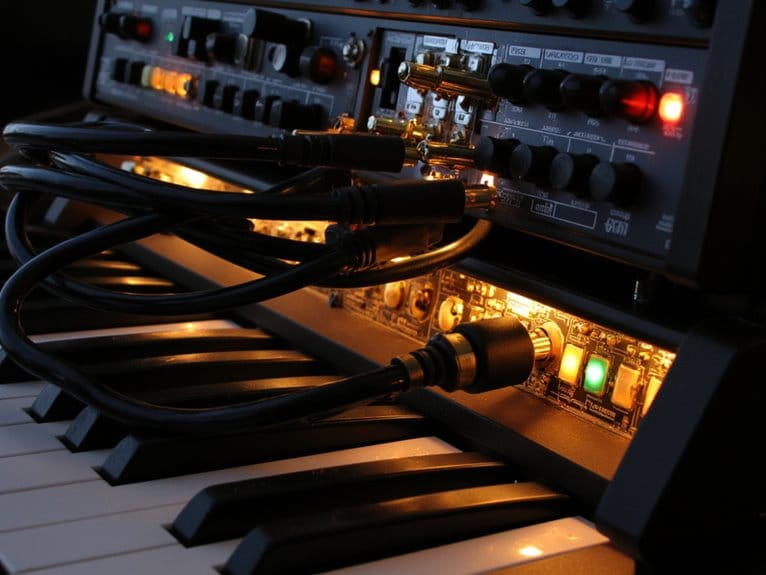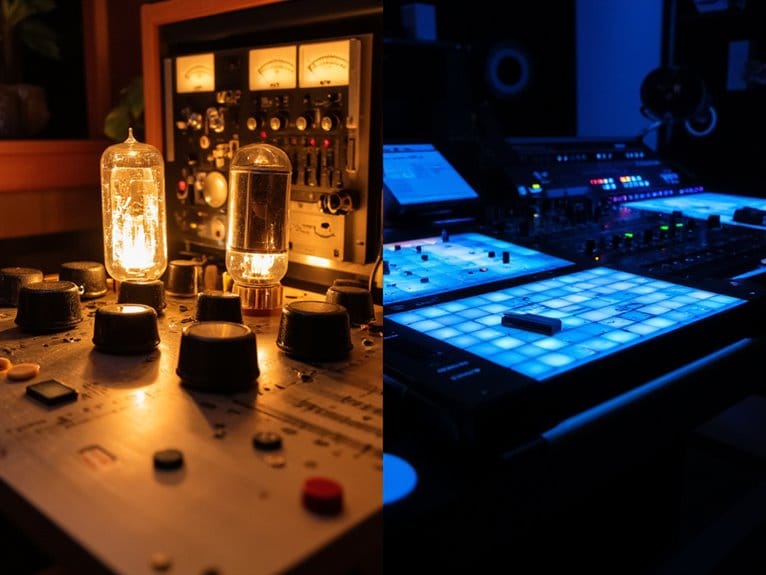What Are In-Ear Monitors and How Do They Work
In-ear monitors are specialized earphones that deliver professional-grade audio directly into your ear canal, primarily used by musicians and performers for precise sound monitoring during live shows or studio recordings. They work through wireless RF transmission systems operating in UHF frequency bands, with receivers decoding signals using FM stereo modulation and 24-bit digital processing for exceptional fidelity. These custom-molded devices feature multiple driver configurations and provide 35dB+ noise isolation, enabling clear audio reproduction without ambient interference-and there’s considerably more to their sophisticated engineering.
We are supported by our audience. When you purchase through links on our site, we may earn an affiliate commission, at no extra cost for you. Learn more.
Notable Insights
- In-ear monitors are specialized earphones that deliver audio directly into the ear canal for precise sound monitoring during performances and recordings.
- They transmit signals via UHF frequency bands (470-937 MHz) using FM stereo modulation with 24-bit digital audio processing for high fidelity.
- IEMs feature custom-molded shells and multiple driver configurations with crossover networks to manage different frequency ranges effectively.
- They provide 35dB+ noise isolation through snug-fitting tips, enabling lower listening volumes while maintaining audio clarity and detail.
- Professional IEMs achieve 20Hz-20kHz frequency response with 110dB sensitivity, creating intimate soundstages free from room acoustics interference.
Understanding In-Ear Monitors: Definition and Core Purpose
When I first encountered in-ear monitors during a backstage visit years ago, I’ll admit I mistook them for fancy earbuds until a sound engineer explained their sophisticated purpose.
You’re looking at specialized earphones that deliver audio directly into your ear canal, designed primarily for musicians, performers, and audio professionals who need precise monitoring during live performances or recordings.
Unlike consumer earbuds, IEM technology focuses on professional-grade sound delivery with minimal latency, ensuring you hear exactly what you need when you need it.
The sound isolation capabilities physically block ambient noise through snug-fitting tips, while tiny internal drivers convert electrical signals into crystal-clear audio that reaches your ears without interference from stage noise or audience volume. Professional-grade models can feature hybrid driver configurations that combine balanced armature and dynamic drivers for superior sound clarity across all frequencies. These systems allow performers to focus on specific audio mixes like isolated vocals or particular instruments rather than hearing everything at once. Quality models typically provide 35dB+ noise isolation to effectively protect performers’ hearing while maintaining crystal-clear audio during loud stage performances.
Design Features and Physical Components
While consumer earbuds prioritize convenience over precision, IEMs are engineered with specialized components that’d make any audio enthusiast appreciate the craftsmanship involved.
You’ll find custom-molded shells crafted from hard acrylic or metal, shaped from exact ear impressions to guarantee perfect ergonomic considerations and superior noise isolation.
Multiple driver configurations inside each earpiece handle different frequency ranges, connected through miniaturized crossover circuits that’d impress any engineer.
Precision-engineered crossover networks route frequencies to specialized drivers, creating a miniaturized audio system that rivals full-sized speakers.
Material choices extend beyond functionality-design aesthetics include various colors and finishes that reflect personal style.
Detachable cables with reinforced shielding offer customization options while preventing interference, and I’ve noticed how the tight seal dramatically reduces external noise leakage, creating an intimate listening environment that transforms your audio experience.
Professional models often feature five-driver setups that provide exceptional sound separation and monitoring capabilities for demanding applications.
High-end IEMs with hybrid driver configurations combine balanced armature and dynamic drivers to achieve superior frequency precision essential for professional monitoring applications.
How In-Ear Monitor Systems Function
Understanding how IEM systems function reveals the sophisticated engineering that transforms audio signals into crystal-clear sound delivered directly to your ears. I’m continually amazed by how these compact devices manage complex signal processing with remarkable precision.
Signal transmission begins when transmitters broadcast stereo or mono audio through UHF frequency bands, typically operating between 470-937 MHz with reliable coverage up to 300 feet. Your receiver decodes these RF signals using FM stereo modulation, converting them through 24-bit digital audio processing that maintains exceptional fidelity with less than 0.9% harmonic distortion.
Companding techniques minimize noise artifacts during wireless transmission, while tiny drivers transform electrical signals into sound waves, creating an acoustic seal that blocks external noise and delivers studio-quality monitoring directly to your eardrums.
Audio Performance and Sound Quality Characteristics
The sophisticated signal processing capabilities of IEM systems ultimately serve one primary purpose: delivering exceptional audio performance that meets the demanding requirements of professional monitoring.
I’ve found that the sound quality characteristics of modern in-ear monitors consistently surpass what most people expect from such compact devices.
You’ll discover that IEMs prioritize balanced frequency response over the bass-heavy signatures common in consumer earbuds, creating natural sound reproduction that audiophiles appreciate.
The superior passive noise isolation enhances sound fidelity by allowing lower listening volumes while preserving detail clarity.
Exceptional noise isolation allows musicians to monitor at safer volumes without sacrificing the critical detail resolution required for professional performance.
Though you’ll notice a more intimate soundstage compared to over-ear headphones due to direct ear canal delivery and sealed positioning.
Professional IEMs achieve studio-grade components with 20Hz-20kHz frequency response and high sensitivity ratings around 110dB to facilitate clear sound reproduction even in noisy stage environments.
Professional and Consumer Applications
You’ll find in-ear monitors serving vastly different roles across the audio landscape, from professional musicians who rely on them for critical stage performance monitoring to home studio engineers crafting detailed mixes in controlled environments.
Whether you’re a touring artist needing custom-molded IEMs for nightly performances, a producer tracking vocals in your bedroom studio, or simply an audiophile seeking reference-quality sound for your daily listening sessions, the applications span an impressive range of user needs and budgets.
I’ve observed that understanding these distinct use cases helps clarify why certain features matter more in professional contexts versus consumer scenarios, and frankly, it explains the dramatic price variations you’ll encounter when shopping for your first serious pair.
Musicians and Live Performance
When you’re standing on stage with amplifiers roaring and crowd noise washing over you, traditional floor monitors often become more of a hindrance than a help, which is precisely why I’ve watched countless musicians make the switch to in-ear monitors over the past decade.
In my experience documenting live performance setups, IEMs fundamentally transform how artists connect with their music and bandmates, delivering personalized monitor mixes that cut through chaotic stage environments with surgical precision.
Whether you’re a weekend warrior playing local clubs or a touring professional maneuvering festival stages, the enhanced musician connection that IEMs provide translates directly into tighter performances, better intonation, and improved stage chemistry that audiences immediately notice.
Studio Recording Environments
Moving from stage performance into the controlled environment of recording studios, I’ve observed how in-ear monitors serve an entirely different yet equally transformative purpose for both professional engineers and home studio enthusiasts.
IEM mobility allows engineers to move freely throughout the studio while maintaining consistent monitoring, while superior sound isolation guarantees precise audio reproduction without room acoustics interfering with critical listening decisions.
Here’s how IEMs revolutionize studio environments:
- Personalized monitoring – Each musician receives their own custom mix directly, eliminating the need for traditional monitor speakers.
- Enhanced precision – Engineers detect subtle mixing nuances that speakers might mask through room reflections.
- Reduced acoustic treatment – No speaker positioning concerns or costly room modifications required.
- Extended session comfort – Lightweight, ergonomic designs prevent ear fatigue during marathon recording sessions.
Audiophile Consumer Market
Beyond the professional domain where I’ve witnessed IEMs transform performances and recording sessions, the audiophile consumer market has emerged as a driving force behind the technology’s rapid evolution. Manufacturers are now targeting discerning listeners who demand studio-quality reproduction in their daily lives.
You’ll find that audiophile preferences have shifted the market toward personalized audio solutions, wireless connectivity with Bluetooth 5+, and enhanced noise-canceling technologies that rival professional-grade equipment.
Market segmentation now includes content creators, fitness enthusiasts, and general consumers seeking high-definition sound reproduction. Brands like Shure and Sennheiser offer varied pricing tiers from budget-conscious options to premium models exceeding $500, addressing different consumer needs while maintaining the ergonomic designs and durability that make IEMs increasingly attractive for everyday use.
Frequently Asked Questions
How Much Do Professional-Grade In-Ear Monitors Typically Cost?
You’ll find professional-grade in-ear monitors ranging from $500 to $3,000+. Budget options start around $200, while premium quality custom models with multiple drivers can cost $2,000-$3,000 for audiophile-grade performance.
Can In-Ear Monitors Cause Hearing Damage With Prolonged Use?
Yes, you’re at risk for hearing damage with prolonged IEM use, especially at high volumes. However, proper hearing protection practices and IEMs’ superior sound isolation can reduce risks by allowing lower listening volumes.
How Do I Properly Clean and Maintain My In-Ear Monitors?
You’ll need proper cleaning techniques including alcohol wipes, brushes, and micro vacuums for debris removal. Essential maintenance tips include using desiccant packs, storing in protective cases, and avoiding moisture to preserve your monitors.
On a final note
You’ve now got the complete picture of in-ear monitors, from their basic design principles to their sophisticated audio engineering. Whether you’re considering IEMs for professional stage work, critical listening, or simply upgrading your daily audio experience, you’ll find models that match your specific needs and budget. The technology continues evolving rapidly, so you can expect even better sound quality, comfort, and features in future generations.

